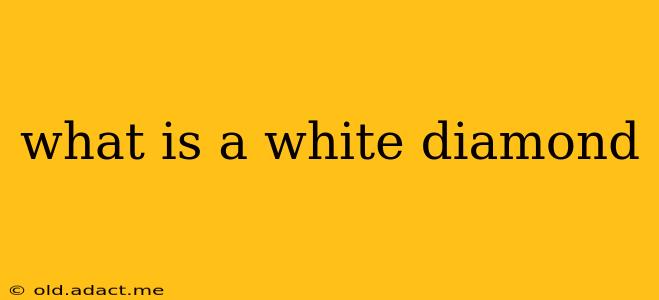A white diamond, often simply called a "diamond," is a gemstone renowned for its exceptional brilliance, fire, and scintillation. It's a crystalline form of pure carbon, subjected to immense pressure and heat deep within the Earth's mantle over billions of years. While the term "white" might suggest a lack of color, most white diamonds actually possess subtle tints, ranging from completely colorless to faintly yellow, brown, or even gray. The absence or near-absence of color is a key factor determining a diamond's value and grade.
What makes a white diamond valuable?
Several factors contribute to a white diamond's value, significantly influencing its price:
-
The 4Cs: The most widely used grading system assesses diamonds based on four key characteristics: Cut, Clarity, Carat, and Color. An excellent cut maximizes brilliance, while high clarity indicates minimal inclusions (internal flaws) and blemishes (external flaws). Carat refers to weight, with larger diamonds generally commanding higher prices. Color refers to the absence of color, with colorless diamonds being the most valuable.
-
Rarity: Exceptionally large, flawless, and colorless diamonds are incredibly rare, driving up their price significantly.
-
Demand: Market demand plays a crucial role. Periods of high demand can lead to increased diamond prices.
-
Brand Reputation: The reputation of the diamond brand and retailer can also impact the perceived value.
What are the different grades of white diamonds?
The Gemological Institute of America (GIA) and other reputable gemological laboratories use standardized grading scales to assess the 4Cs. These scales allow for consistent evaluation and comparison of diamonds. For instance, color is graded on an alphabetical scale, with D representing colorless and Z representing light yellow or brown. Clarity grades range from Flawless (FL) to Included (I), describing the presence and visibility of inclusions.
What are some common misconceptions about white diamonds?
Are all white diamonds mined? No, a growing number of white diamonds are now lab-grown, offering a more sustainable and often more affordable alternative.
Are all white diamonds the same? Absolutely not. The variations in the 4Cs result in a vast range of quality and price points.
Are white diamonds a good investment? Diamonds are considered a luxury asset rather than a purely financial investment. Their resale value can fluctuate based on market conditions.
What is the difference between a white diamond and a colorless diamond?
The terms are often used interchangeably. However, "colorless" refers specifically to diamonds graded D or possibly E on the GIA color scale, indicating a complete absence of color to the naked eye. "White" is a broader term that encompasses diamonds with subtle tints of color that are still considered commercially viable.
How can I tell if a white diamond is real?
It is best to purchase from reputable jewelers who provide certificates from recognized gemological laboratories (like GIA, AGS, or IGI). These certificates provide detailed grading information, confirming the diamond's authenticity and quality. A jeweler with expertise can also help you identify potential signs of a fake diamond, though sophisticated fakes can be difficult to detect without professional equipment.
Where do white diamonds come from?
White diamonds are primarily mined from several locations worldwide, including Africa (South Africa, Botswana, Namibia, etc.), Russia, Canada, and Australia. However, a significant portion of the market now consists of lab-grown diamonds.
In conclusion, understanding the qualities and factors influencing the value of a white diamond is crucial for making informed decisions. Whether you're considering an investment or a personal purchase, remember that reputable sources and thorough research are essential to ensure you get the diamond that best suits your needs and expectations.
